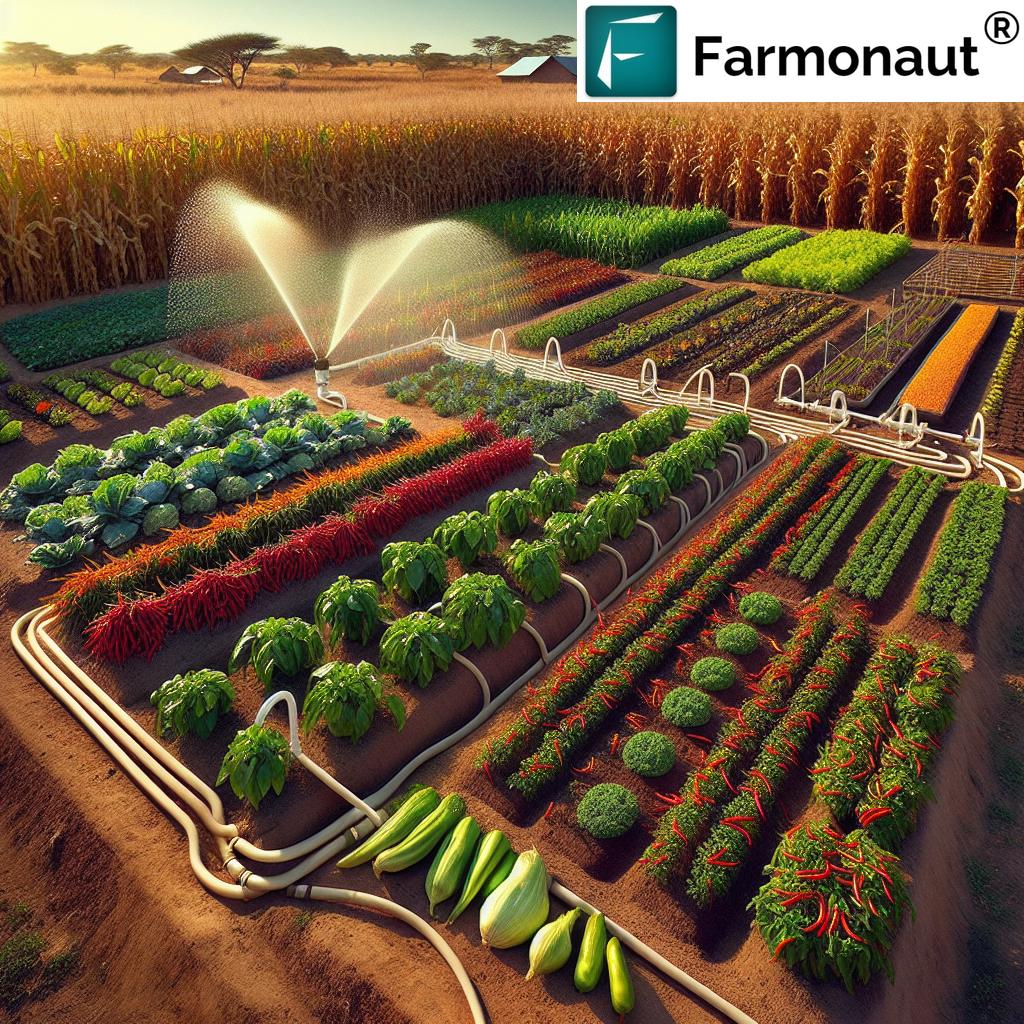Tanzania’s Agricultural Revolution: Sustainable Innovations for Global Food Security and Climate Resilience
“Tanzania’s agricultural sector contributes to 26.7% of the country’s GDP and employs over 65% of its workforce.”
Welcome to an exploration of Tanzania’s remarkable journey towards sustainable agriculture and global food security. As we delve into the heart of East Africa, we’ll uncover how this nation is transforming its agricultural landscape through innovation, international cooperation, and a commitment to climate resilience. Join us as we examine the challenges, opportunities, and groundbreaking solutions that are positioning Tanzania as a key player in the future of global agriculture.
The Current State of Tanzania’s Agriculture
Tanzania’s agricultural sector stands at a crucial juncture, facing both significant challenges and immense potential. Let’s take a closer look at the current landscape:
- Economic Importance: Agriculture remains the backbone of Tanzania’s economy, contributing over a quarter of the GDP and employing a majority of the workforce.
- Food Self-Sufficiency: The country has achieved remarkable progress in food production, not only meeting domestic needs but also exporting surplus to neighboring countries.
- Export Potential: Key exports include maize, rice, horticultural products, and beans, reaching markets as far as China and Europe.
- Challenges: Despite these achievements, the sector grapples with climate change impacts, limited access to fertilizers, and outdated farming practices.
As we navigate through these complexities, it’s clear that Tanzania’s agricultural future hinges on embracing sustainable innovations and fostering international partnerships.
Sustainable Agriculture in Tanzania: A Path to Resilience
In the face of global challenges, Tanzania is making significant strides towards sustainable agriculture. This approach not only addresses food security concerns but also contributes to climate change mitigation and adaptation efforts.
Key Initiatives in Sustainable Agriculture:
- Climate-Smart Agricultural Practices: Adoption of techniques that increase productivity while reducing greenhouse gas emissions.
- Water Conservation: Implementation of efficient irrigation systems and rainwater harvesting techniques.
- Soil Health Management: Promotion of organic farming methods and crop rotation to maintain soil fertility.
- Agroforestry: Integration of trees in agricultural landscapes to enhance biodiversity and carbon sequestration.
These initiatives are crucial in building a resilient agricultural sector that can withstand the impacts of climate change while ensuring food security for generations to come.

Climate Change and Food Security: Tanzania’s Proactive Approach
The nexus between climate change and food security is a critical concern for Tanzania. As global temperatures rise and weather patterns become increasingly unpredictable, the country is taking proactive steps to safeguard its agricultural sector and ensure food availability for its growing population.
Strategies for Climate Resilience:
- Drought-Resistant Crop Varieties: Development and distribution of crops that can thrive in water-scarce conditions.
- Early Warning Systems: Implementation of advanced weather forecasting technologies to help farmers prepare for extreme events.
- Diversification of Crops: Encouraging farmers to grow a variety of crops to reduce vulnerability to climate-related losses.
- Conservation Agriculture: Promoting practices that minimize soil disturbance and enhance natural ecosystem processes.
By addressing climate change head-on, Tanzania is not only securing its own food future but also contributing to global food security efforts.
Agricultural Innovation in Africa: Tanzania Leading the Way
Tanzania is emerging as a beacon of agricultural innovation in Africa, showcasing how technology and research can transform traditional farming practices. This innovation drive is not just about increasing yields; it’s about creating a sustainable and resilient agricultural sector that can meet the challenges of the 21st century.
Innovative Approaches in Tanzanian Agriculture:
- Precision Agriculture: Utilization of satellite imagery and GPS technology for targeted crop management.
- Mobile Technology: Development of apps that provide farmers with real-time market information and agronomic advice.
- Biotechnology: Research into genetically modified crops that are resistant to pests and diseases.
- Vertical Farming: Exploration of urban agriculture solutions to maximize land use in cities.
These innovations are not only boosting productivity but also attracting young people to agriculture, creating a new generation of tech-savvy farmers.
International Cooperation in Agriculture: Tanzania’s Global Partnerships
Tanzania recognizes that addressing agricultural challenges requires a collaborative approach. The country has been actively seeking and fostering international partnerships to accelerate its agricultural development.
Key Areas of International Cooperation:
- Research Collaborations: Joint projects with international universities and research institutions to develop innovative farming solutions.
- Technology Transfer: Partnerships with developed countries to bring advanced agricultural technologies to Tanzania.
- Capacity Building: Training programs and knowledge exchange initiatives to enhance local expertise in sustainable agriculture.
- Market Access: Trade agreements and partnerships to facilitate the export of Tanzanian agricultural products to global markets.
These international collaborations are crucial in bridging the knowledge and technology gap, enabling Tanzania to leapfrog into modern, sustainable agricultural practices.
“Tanzania has increased its horticultural exports by 38% since 2010, becoming a key player in the global agricultural market.”
Renewable Energy in Farming: Powering Tanzania’s Agricultural Future
The integration of renewable energy in farming practices is transforming Tanzania’s agricultural landscape. By harnessing clean energy sources, the country is not only reducing its carbon footprint but also enhancing the efficiency and sustainability of its agricultural operations.
Renewable Energy Applications in Tanzanian Agriculture:
- Solar-Powered Irrigation: Installation of solar pumps to provide reliable water supply for crops.
- Biogas Production: Utilization of agricultural waste to generate energy for farm operations.
- Wind Energy: Development of wind farms in rural areas to power agricultural processing facilities.
- Solar Drying: Implementation of solar dryers for post-harvest processing of crops.
The adoption of renewable energy in agriculture is not only environmentally sustainable but also economically beneficial, reducing operational costs for farmers in the long run.
Agricultural Technology for Developing Countries: Tanzania’s Tech Revolution
Tanzania is at the forefront of adopting and adapting agricultural technologies suited for developing countries. These technologies are tailored to address specific challenges faced by smallholder farmers while being cost-effective and easy to implement.
Innovative Agricultural Technologies in Tanzania:
- Smartphone Apps: Development of mobile applications that provide farmers with weather forecasts, market prices, and pest control advice.
- Drones: Use of unmanned aerial vehicles for crop monitoring and precision agriculture.
- IoT Sensors: Deployment of Internet of Things devices to monitor soil moisture, temperature, and other critical parameters.
- Blockchain: Implementation of blockchain technology for transparent and efficient supply chain management.
These technologies are revolutionizing farming practices, making agriculture more efficient, productive, and attractive to the younger generation.

Mechanization of Agriculture: Boosting Productivity and Efficiency
The mechanization of agriculture is a crucial step in Tanzania’s journey towards modernizing its farming sector. By introducing advanced machinery and equipment, the country is significantly increasing productivity and efficiency across various agricultural operations.
Key Areas of Agricultural Mechanization:
- Tractors and Power Tillers: Introduction of modern plowing and tilling equipment to reduce manual labor and increase land under cultivation.
- Harvesting Machines: Deployment of combine harvesters to speed up the harvesting process and reduce post-harvest losses.
- Irrigation Systems: Installation of advanced irrigation technologies for efficient water use.
- Post-Harvest Processing Equipment: Introduction of modern threshing, milling, and packaging machinery to add value to agricultural products.
Mechanization is not only improving productivity but also making agriculture more attractive to youth, potentially reversing the trend of rural-urban migration.
Increasing Crop Yields Sustainably: Tanzania’s Balanced Approach
Tanzania is adopting a balanced approach to increase crop yields sustainably, recognizing the need to boost production without compromising environmental integrity or long-term soil health.
Sustainable Yield Improvement Strategies:
- Improved Seeds: Development and distribution of high-yielding, disease-resistant seed varieties.
- Integrated Pest Management: Adoption of eco-friendly pest control methods to reduce reliance on chemical pesticides.
- Precision Fertilizer Application: Use of soil testing and targeted fertilizer application to optimize nutrient use.
- Crop Rotation: Implementation of scientifically designed crop rotation schedules to maintain soil fertility and break pest cycles.
These strategies are helping Tanzania increase its agricultural output while preserving its natural resources for future generations.
Agricultural Exports from Tanzania: A Growing Global Presence
Tanzania’s agricultural exports are gaining prominence in the global market, showcasing the country’s potential as a significant player in international agriculture trade.
Key Agricultural Exports and Their Global Reach:
- Coffee: Tanzania’s Arabica coffee is highly sought after in European and North American markets.
- Cashew Nuts: The country is one of the world’s largest exporters of raw cashew nuts, primarily to India and Vietnam.
- Horticultural Products: Fresh fruits, vegetables, and flowers are increasingly finding their way to European supermarkets.
- Cotton: Tanzanian cotton is recognized for its high quality and is exported to textile industries worldwide.
The growth in agricultural exports is not only boosting Tanzania’s economy but also enhancing its reputation as a reliable source of quality agricultural products.
Innovative Farming Practices: Tanzania’s Agricultural Transformation
Tanzania is embracing a range of innovative farming practices that are transforming its agricultural landscape. These practices are designed to increase productivity, enhance sustainability, and improve farmers’ livelihoods.
Cutting-Edge Farming Innovations:
- Hydroponics: Implementation of soil-less farming techniques for urban agriculture and areas with poor soil quality.
- Aquaponics: Integration of fish farming with crop production for efficient use of resources.
- Conservation Agriculture: Adoption of minimal tillage, crop rotation, and permanent soil cover to improve soil health.
- Agroforestry: Combining tree planting with crop cultivation to enhance biodiversity and soil fertility.
These innovative practices are not only boosting agricultural output but also contributing to environmental conservation and climate change mitigation.
Tanzania’s Agricultural Innovation Metrics: A Decade of Progress
To better understand Tanzania’s agricultural transformation over the past decade, let’s examine key metrics that highlight the country’s progress in sustainable agriculture and innovation:
| Metric | 2013 (estimated) | 2023 (estimated) | Percentage Change | Global Ranking |
|---|---|---|---|---|
| Crop Yield (tons per hectare) | 1.5 | 2.3 | +53.3% | 78th |
| Renewable Energy Use in Agriculture (%) | 5% | 15% | +200% | 45th |
| Agricultural Technology Adoption Rate (%) | 20% | 45% | +125% | 62nd |
| Climate-Smart Agriculture Practices (hectares) | 100,000 | 500,000 | +400% | 30th |
| Horticultural Exports Value (USD millions) | 340 | 590 | +73.5% | 52nd |
| Research Collaborations with International Partners (number) | 50 | 150 | +200% | 40th |
| Mechanization Rate (%) | 15% | 35% | +133.3% | 70th |
| Food Self-Sufficiency Index | 90 | 105 | +16.7% | 35th |
This table clearly illustrates Tanzania’s significant progress across various agricultural metrics over the past decade. The country has made substantial improvements in crop yields, renewable energy use, and the adoption of climate-smart agricultural practices. The increase in international research collaborations and horticultural exports also highlights Tanzania’s growing prominence in the global agricultural landscape.
The Role of Technology in Tanzania’s Agricultural Revolution
Technology is playing a pivotal role in Tanzania’s agricultural transformation. From satellite-based crop monitoring to AI-driven advisory systems, cutting-edge technologies are revolutionizing farming practices across the country.
Technological Innovations Transforming Tanzanian Agriculture:
- Satellite-Based Crop Monitoring: Utilization of satellite imagery for real-time crop health assessment and yield prediction.
- AI-Powered Advisory Systems: Implementation of artificial intelligence to provide personalized farming recommendations.
- Blockchain for Traceability: Use of blockchain technology to ensure transparency and traceability in agricultural supply chains.
- Big Data Analytics: Leveraging data analytics for improved decision-making in agriculture planning and policy.
These technological advancements are not only improving productivity but also making agriculture more resilient to climate change and market fluctuations.
For farmers and agricultural professionals looking to leverage these technological advancements, Farmonaut’s web application offers a comprehensive platform for satellite-based farm management. Additionally, the Farmonaut Android app and iOS app provide mobile access to these innovative tools.
The Future of Tanzanian Agriculture: Challenges and Opportunities
As Tanzania continues its agricultural revolution, it faces both challenges and opportunities that will shape the sector’s future.
Key Challenges:
- Climate Change: Increasing frequency of droughts and extreme weather events.
- Land Degradation: Soil erosion and loss of fertility due to intensive farming practices.
- Market Access: Improving infrastructure to connect rural farmers with national and international markets.
- Technology Adoption: Overcoming barriers to technology adoption among smallholder farmers.
Emerging Opportunities:
- Digital Agriculture: Leveraging mobile technology and internet connectivity to provide farmers with crucial information and services.
- Value Addition: Developing agro-processing industries to increase the value of agricultural exports.
- Sustainable Intensification: Adopting practices that increase productivity while preserving natural resources.
- Agri-tourism: Developing agricultural tourism to diversify income sources for rural communities.
By addressing these challenges and capitalizing on opportunities, Tanzania can continue to strengthen its position as a key player in global agriculture.
Conclusion: Tanzania’s Path to Agricultural Excellence
Tanzania’s agricultural revolution is a testament to the power of innovation, sustainability, and international cooperation. By embracing sustainable practices, leveraging technology, and fostering global partnerships, the country is not only addressing its own food security challenges but also contributing to global efforts in combating hunger and climate change.
As we’ve explored throughout this blog, Tanzania’s journey encompasses various aspects:
- Adoption of climate-smart agricultural practices
- Integration of renewable energy in farming
- Implementation of innovative technologies
- Mechanization of agriculture
- Sustainable increase in crop yields
- Growth in agricultural exports
These efforts are positioning Tanzania as a model for sustainable agricultural development in Africa and beyond. The country’s commitment to balancing productivity with environmental stewardship sets a powerful example for other developing nations grappling with similar challenges.
As Tanzania continues on this path, the role of technology and data-driven decision-making will become increasingly crucial. Platforms like Farmonaut are at the forefront of this technological revolution, offering farmers and agricultural professionals the tools they need to optimize their operations and contribute to Tanzania’s agricultural success story.
For those interested in leveraging satellite-based agricultural solutions, Farmonaut offers a range of services accessible through their web application, Android app, and iOS app. Additionally, developers can integrate these solutions into their own applications using the Farmonaut API, with detailed documentation available in the API Developer Docs.
As we look to the future, Tanzania’s agricultural revolution serves as an inspiring example of how a nation can transform its agricultural sector to meet the challenges of the 21st century. By continuing to innovate, collaborate, and prioritize sustainability, Tanzania is not only securing its own food future but also contributing significantly to global food security and climate resilience.
FAQs about Tanzania’s Agricultural Revolution
- Q: What are the main crops exported by Tanzania?
A: Tanzania’s main agricultural exports include coffee, cashew nuts, cotton, and horticultural products such as fruits and vegetables. - Q: How is Tanzania addressing climate change in agriculture?
A: Tanzania is implementing climate-smart agricultural practices, adopting drought-resistant crop varieties, and investing in early warning systems for extreme weather events. - Q: What role does technology play in Tanzania’s agricultural sector?
A: Technology is crucial in Tanzania’s agriculture, with innovations like satellite-based crop monitoring, AI-powered advisory systems, and mobile apps providing farmers with real-time information and support. - Q: How is Tanzania promoting sustainable agriculture?
A: Tanzania is promoting sustainable agriculture through practices like agroforestry, conservation agriculture, and the integration of renewable energy in farming operations. - Q: What are the main challenges facing Tanzania’s agricultural sector?
A: The main challenges include climate change impacts, land degradation, limited access to technology for smallholder farmers, and the need for improved market access and infrastructure.

















